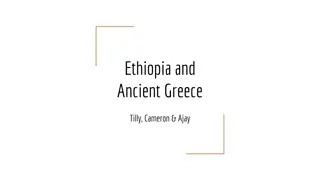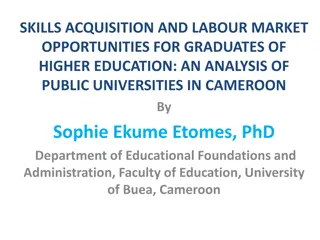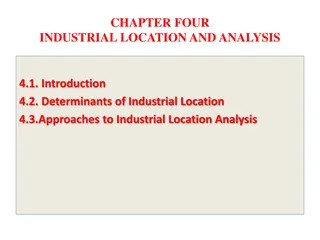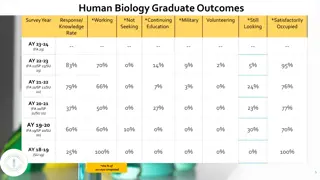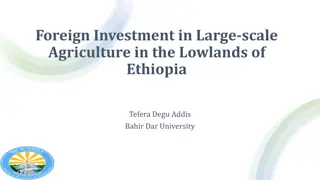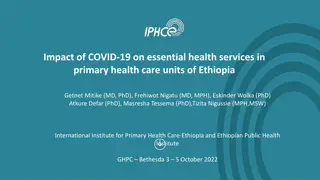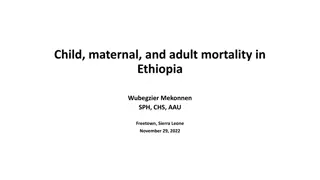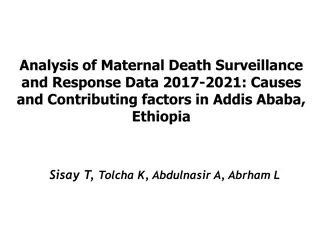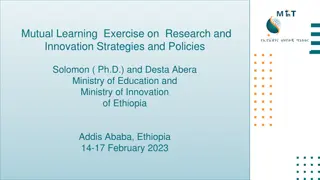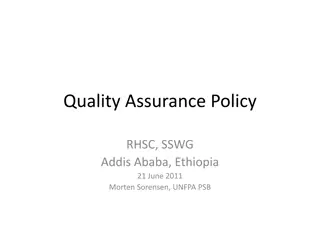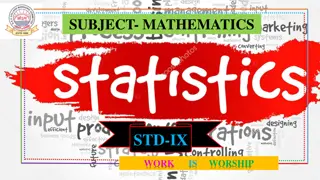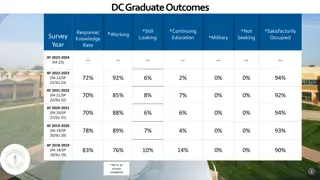Study on Employability Among Statistics Graduates in Ethiopia
Graduate employability is a pressing issue in Ethiopia, with rising unemployment rates among graduates. This study focuses on the employability and skills of statistics graduates from Bahir Dar University, aiming to bridge the gap between graduates' competencies and employers' demands. Primary data collection was conducted via an online and direct survey from 2012 to 2016 graduates, with a systematic sampling technique. The findings will provide insights into enhancing graduates' readiness for the workforce.
Download Presentation

Please find below an Image/Link to download the presentation.
The content on the website is provided AS IS for your information and personal use only. It may not be sold, licensed, or shared on other websites without obtaining consent from the author. Download presentation by click this link. If you encounter any issues during the download, it is possible that the publisher has removed the file from their server.
E N D
Presentation Transcript
Employability among Statistics Graduates Ashenafi Abate Woya, Bahir Dar ,ashu.abate@gmail.com Date: ( Month Year) Session number: 7.1``````````````````````````````````````````````` ``````````````````````````````````````````
1. Introduction 2. Methodology 3. Result 4. Conclusion 5. Suggestions Presentation outline 2
Introduction: Employment Graduate employability is a major concern for government and universities in Ethiopia. The unemployment rate in Ethiopia was 2.29%, according to a World Bank report in 2016. The unemployment rate is rising every year in Ethiopia. Various studies have shown that the number of unemployed university graduates is increasing every year in Ethiopia. The majority of graduates in Ethiopia are unemployed. Hundreds of unemployed university graduates are demanding that the government provide them jobs.
Introduction: Employability The number of universities programs; however, there is an imbalance between the number of graduates and employment in various institutions. One of the questions about graduates employability is about their competencies. . Employers think that graduates are unprepared for the workforce. in Ethiopia has increased, and they offer a variety of AND Also Employers believed that academic standards had fallen considerably over the past decade.
Introduction: Competency Thus, graduates' competencies must align with what companies require. But it is not known to what extent graduates competence aligns with the demands of the employers. Therefore, to make the curriculum of the program responsive to the demand from potential employers, conducting this research has become a necessity. Thus, this study examined the employability and employability skills of statistics graduates from Bahir Dar University.
Methodology Data source: Primary data source was used. The target population was all regular statistics graduates from 2012 2016. Data collection : The data was collected using an online and direct questionnaire survey. Study Design: A cross-sectional study design was used to collect data from October 2017 to January 2018 Among 302 graduates, 79 were included using the single population proportion sample size formula.. A systematic sampling technique was employed based on student identification numbers. Sampling : 6
Methodology Employability and employability skill were study variables a full-time or part-time worker during the data collection period. Employed graduates Employability without a paid job during the data collection period. Communication skills; Knowledge and self-reliance; Research and problems solving skills; Self-responsibility Self-confidence; Personal improvement Unemployed graduate Eployability skill All questions about employability skills were assessed on a five-point Likert scale.
Methodology Analysis Descriptive Log-rank tests. Kaplan Meier estimate was used to describe data. compute time to unemployed/ duration of unemployment was used to assess whether there is a real difference between groups. 8
Results: Employability The results of this study show that the employability rate for graduates is decreasing year over year. Among the graduates included in this study, 18% were unemployed, while 82% were employed. In 2015, 28% of graduates were unemployed, and in 2016, 40% of graduates were unemployed. The employability rate was reduced in the consecutive years when we have seen from 20112 to 2016 graduates.
Results The rate of employability was assessed based on their sex. 40% of reported female graduates were unemployed, while 10% of graduates were unemployed men. Female graduates are more likely to be unemployed than male graduates. 75% of graduates live in the Amhara region. Of these graduates, 20% were unemployed, and the remaining 10.5% were unemployed in other regions. Unemployment in the Amhara region is higher than other regions.
Results Variables Categories Employability Unemployed Frequency(Percentage) Employed Frequency(Percentage) Year of graduation 2012 year 2013 year 2014 year 2015 year 2016 year Total Male Female Amhara region Other regions Public media Direct contact with employer 0 (0.0%) 0(0%) 0(0.0%) 0(0.0%) 8 (27.6%) 6 (40%) 14 (17.7%) 6 (10.2%) 8 (40.0%) 12 (20.3%) 2 (10.5%) 13 (20.6%) 16(100%) 5(100%) 14(100%) 21 (72.4%) 9 (60%) 65 (82.3%) 53 (89.8%) 12 (60.0%) 47 (79.7%) 17 (89.5) 50 (79.4%) 4 (100.0%) Gender Region where graduate lives Types of job searching Internet or websites Others Before graduation After graduation 1 (11.1%) 0 (0%) 1 (33.3%) 13 (17.3%) 7 (17.1%) 7(18.9%) 9 (16.7%) 5(20.8%) 8 (88.9%) 3 (100%) 2 (66.7%) 62 (82.7%) 34 (82.9%) 30(81.1%) 4 5(83.3%) 19(79.2) Looking for a job Father Education Uneducated Educate Mothers Education Uneducated Educate
Time to unemployed/duration of unemployment The minimum and maximum unemployment durations for statistics graduates were one month and 36 months, respectively. The mean and median duration of unemployment for statistics graduates were 13 months and 6 months, respectively. The duration of unemployment for female graduates was 22.25 months, while for male graduates it was 9.754 months.
Means and Medians time to unemployed Variable Category Meana Median 95% Confidence Interval (13.675,58.325) .512 (3.996,6.004) 2.500 (0.000,7.900) 3.266 (0.000,11.401) 1.309 (5.434,10.566) .378 (5.259,6.741) 12.021 (0.000,26.561) .756 (3.518,6.482) 4.404 (0.000,14.632) 2.500 (0.000,7.900) .365 (5.284,6.716) Estimate Std. Error 95% Confidence Interval Estimate Std. Error Gender female Male 2.0 -2.25 2.25- .50 2.50 -2.75 2.75- 3.00 3.00 - 3.25 3.25 - 3.50 3.50 -3.75 3.75 -4.00 Overall 22.25 9.754 11.500 5.667 10.286 12.000 19.125 12.286 11.818 11.500 12.929 3.583 (15.227,29.273) 1.46 (6.893,12.615) 7.128 (0.000,25.471) 2.906 (0.000,11.362) 2.397 (5.588,14.983) 2.709 (6.691,17.309) 6.540 (6.307,31.943) 3.041 (6.325,18.246) 3.085 (5.772,17.865) 8.231 (0.000,27.633) 1.527 (9.935,15.922) 36.00 5.000 3.000 5.000 8.000 6.000 3.000 5.000 6.000 3.000 6.000 11.390 CGPA Overall Comparisons Chi-Square Variable Sex CGPA df Sig. 0.003* Log Rank (Mantel-Cox) Log Rank (Mantel-Cox) 9.122 1 2.434 7 0.932 The unemployment rate decreases gradually as the months increase.
Employee graduates The majority (80%) of the graduates were working in government organisations. More than half (66%) of the graduates obtained their first job by taking the organization's entrance exam. 80% of graduates were employed permanently, and the remaining 20% were employed temporarily. 70% of the respondents said that their work directly aligns with the study of the field, while 29% of the graduates who are working do not directly align with the study of the field.
Employed characteristics Frequency 52 (80%) Variables Variables Permanent Types of work Temporary 13 (20%) 46 (70.77%) Yes your job align with your study field No 19 (29.23%) CGPA 11 (16.92%) 43 (66.15%) obtained their first job /Selecting candidate Entrance exams Others 11(16.92%) Government organization 52(80.0%) Employees organization NGO 6(9.4%) Private 7(10.9%)
Asssising courses Delivery and Evaluation The courses are assessed based on teaching methods, assessments, and materials. Delivery of education material Use of teaching aid and technologies Providing continuous assessment and feedback On course evaluation questions, the majority of respondents gave it a "good" or "fair" rating. Suitability of Evaluation in each courses Delivering education with support of practical activity Student center delivery by the instructors Contribution of the courses to your present work Courses delivery order and relationship 0.00% 10.00% 20.00% 30.00% 40.00% Very good Good Fair poor Very poor
courses Delivery and Evaluation by courses order and coherence 23% of the respondents replied that the order of courses and coherence of the courses were rated as very good courses order 43% of the respondents replied that the courses order of delivery and their coherence were good about 24% of them said that the courses order of delivery and their relationship were rated as fair . Thus, based on the majority of the respondents, the course order and coherence in the department were good.
Courses contribution their current work. 30%, 20%, and 25% respondents replied that courses contribution their current jobs as "very good," "good," and "fair" . contribution of the career As a result, it may be possible to conclude that the courses taken in the departments were relevant to their current jobs. .
Modes of delivery Regarding the modes of delivery, the majority of the graduates compiled that the courses delivered by the departments . about 62% of the respondents replied as rated poor 30% of them agreed that course delivery follows a student-centered approach. Thus, the majority of the graduates were not engaged in student-centered types of teaching- learning activities.
Graduates employability skills The employability of graduates was assessed using different parameters including communication skills; knowledge and self-reliance; research and problems solving skills; self-responsibility self-confidence; personal improvement
Graduates employability skills Items Not at all 4(2.5%) Very little 6(7.6%) 26(32.9%) 29(36.7) Fair Adequa tely Very well 9(11.4 G1. The department has helped me to communicate, clarify, and communicate my work-related issues clearly. G2. The department helped me to express my ideas clearly in writing. G3. The department helped me to read and speak Amharic/English. I. Communicati on skills 2(2.5%) 2(2.5%) 29(36.7%) 30(39%) 14(14) 10(12.7) 11(13.9% 24(30.4%) 18(22.8 11(13.9) ) %) Knowledge and skills acquired in departments help graduates communicate and express ideas easily.
Graduates employability skills Items Not at all 0(0%) Very little 4(5.1%) Fair Adequ ately Very well 20(25.3) G8. The department helped me to use statistical techniques for solving problems and make decisions. G10. The department made me able to evaluate and solve problems and make decisions at every level. G11. The accuracy of facts helped me to review it based on facts. 21(26.6%) 31(39.2%) II. Research and problems solving skills 0(0%) 3(3.8%) 23(29.1) 36(45.6%) 14(17.7%) 0 (0%) 4 (5.4%) 23(29.1%) 31(39.1%) 18(22.8%) G12. The department improved me on research skills, like collection, analysis of important information. 1 (1.3%) 2 (2.5%) 22 (24%) 24 (30.4%) 25 (31.6%) the tabel shoe that the research and problem-solving skills they gained from the department are adequate.
Overall employability skill Fair Adequately items Not at all Very little Very well Brief explained to do work Express ideas in writing read and speak English Knowledge of the field Knowledge related work Relevant skills Understand different concept my own way 4(5.1%) 2(2.5%) 10(12.7%) 3(3.8%) 7(8.9%) 3(3.8%) 1(1.3%) 6(7.6%) 2(2.5%) 11(13.9%) 6(7.6%) 9(11.4%) 7(8.9%) 4(5.1%) 26(32.9%) 29(36.7%) 24(30.4%) 18(22.8%) 17(21.5%) 25(31.6%) 26(32.9%) 29(36.7%) 30(39.0%) 18(22.8%) 37(46.8%) 27(34.2%) 26(32.9%) 26(32.9%) 9(11.4%) 14(17.7%) 11(13.9%) 11913.9%) 14(17.7%) 14(17.7%) 20(25.3%) person al attribut es Test Value = 3 Sig. (2- tailed ) .000 t df Mean Differ ence 95% CI Lower Upp er Make decision by statistical techniques 0(0%) 4(5.1%) 21(26.6%) 31(39.2%) 20(25.3%) Basic skill of computer To solve and decision making problem Review is based on the fact Provided research skills To work my colleagues in an effective 0(0%) 0(0%) 3(3.8%) 3(3.8%) 16(20.3%) 23(29.1%) 33(41.8%) 36(45.6%) 24(30.4%) 14(17.7% 10.4 76 .6220 .5029 .741 0 7 2 0(0%) 1(1.3%) 2(2.5%) 4(5.4) 2(2.5%) 3(3.8%) 23(29.1%) 22(24%) 25(31.6%) 31(39.1%) 24(30.4%) 32(40.5%) 18(22.8%) 25(31.6%) 12(15.2%) The results show that statistics graduates are employability skills. Lead the people The ability to plan and organize project work 2(2.5%) 1(1.3%) 6(7.6%) 3(3.8%) 32(40.5%) 29(36.7%)) 22(27.8%) 32(40.5%) 12(15.2%) 10(12.7%) competent in To do my work on plane To do work properly to do work effectively and on time 2(2.5%) 1(1.3%) 1(1.3%) 3(3.8%) 5(6.3%) 6(7.6%) 26(32.9%) 25(31.6%) 24(30.4%) 30(38.0%) 35(44.3%) 34(43.0%)) 14(17.7%) 10(12.7%) 9(11.4%) New way to do my work To using updating knowledge for work 1(1.3%) 1(1.3%) 11(13.9%) 12(15.2%) 32(40.5%) 28(35.4%) 26(32.9%) 21(26.6%) 6(7.6%) 13(16.5%) To Take responsibility To acquire knowledge To improve my self esteem Being open for improvement 1(1.3%) 2(2.5%) 2(2.5%) 1(1.3%) 7(8.9%) 5(6.3%) 7(8.9%) 1(1.3%) 26(32.9%) 30(38.0%) 29(36.7%) 26(32.9%) 34(43.0%) 29(36.7%) 28(35.4%) 35(44.3%) 9(11.4%) 10(12.7%) 9(11.4%) 14(17.7%) Understand social problem 3(3.8%) 3(3.8%) 19(24.1%) 34(43.0%) 16(20.3%)
Conclusion The study showed that 17.7% of graduates were unemployed, and the average time to get a first job for Statistics graduates was 13 months, 95% CI (9.935, 15.922). The graduates' responses show that the knowledge and skills they gained from department are important to their current jobs. The result of this study indicates that graduates have sufficient knowledge, skills, and competencies for current jobs.
Suggestions The graduates' employability rate is decreasing. The departments should establish collaboration with employers and organisations. The department should enrich its curricular programs to enhance graduates' knowledge, skills, and personal qualities. This study's findings are insufficient to draw conclusions about the employment rates and employability skills of statistics graduates. The department will reassess graduates' competency and employability skills using this study's findings as a benchmark.. .
Thank you 26




